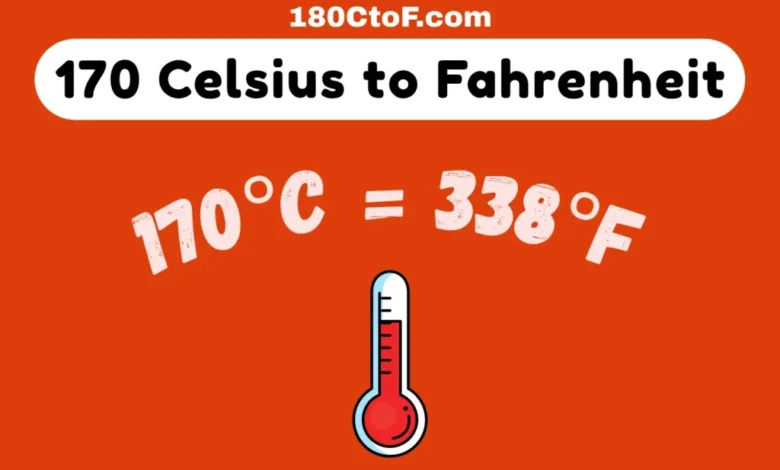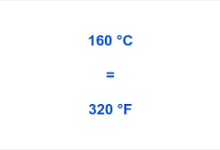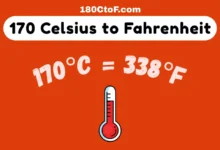170 c to f – Easy Temperature Conversion for Everyday Use

170 c to f is a temperature conversion many people look for when cooking or baking. If you have a recipe in Celsius but your oven only shows Fahrenheit, you need to know the right number. This helps you avoid burning your cake or undercooking your meal. The good thing is, converting 170 c to f is not difficult at all. Once you understand the simple formula, you can do it in seconds. In fact, this temperature is very common in kitchens around the world, especially for baking bread, cookies, or roasting vegetables. By learning how to change 170 c to f correctly, you can follow recipes from any country. You do not need to be a math genius; just a little trick can make it easy. In this post, we will explain the exact answer, show you quick methods, and share real-life examples where you use it.
170 c to f – The Exact Answer You Need Right Now
170 c to f is one of the most common temperature conversions people search for, especially when cooking. If you change 170°C into Fahrenheit using the standard formula, you get 338°F. This is the exact number you need if your oven only shows Fahrenheit settings but your recipe is written in Celsius. Many bakers and chefs worldwide work with 170°C for gentle baking, roasting, and slow cooking. It is not too hot to burn food quickly and not too low to undercook it. This temperature allows flavors to develop slowly, giving better taste and texture. Remember, when converting any Celsius temperature to Fahrenheit, you multiply the Celsius number by 9, divide it by 5, and then add 32. Once you learn this, you will never worry about switching between Celsius and Fahrenheit again. In this blog, we will explore this conversion in detail.
Simple Formula to Convert 170°C into Fahrenheit Without Mistakes
The correct way to change 170°C into Fahrenheit is by using the trusted formula: Fahrenheit = (Celsius × 9 ÷ 5) + 32. Let’s break it down simply. First, multiply 170 by 9, which equals 1,530. Then, divide 1,530 by 5 to get 306. Finally, add 32, and you have 338°F. This method works every single time, no matter what temperature you start with. Many people make mistakes by forgetting the order of steps or by guessing. But guessing can lead to wrong results, especially in cooking where even a small temperature change can affect the outcome. If you remember “times nine, divide by five, plus thirty-two,” you’ll always get it right. You can also use online temperature converters for speed, but knowing the formula helps when you don’t have internet. This simple method is the key to accurate kitchen and science work.
Quick Kitchen Trick to Remember 170 c to f
If you do not like doing math, here’s a quick memory trick for 170 c to f. First, know that 100°C is 212°F. From there, every extra 10°C is about 18°F more. So if you go from 100°C to 170°C, that’s 70°C more, which is about 126°F extra. Add that to 212°F, and you get around 338°F. This method is not exact like the formula but it’s very close and works well for cooking. Many chefs use this quick thinking when adjusting oven temperatures without calculators. You can also write down common conversions like 160°C = 320°F, 170°C = 338°F, and 180°C = 356°F on a small note in your kitchen. Over time, you’ll remember them without looking. The key is to practice with different numbers so it becomes natural. Soon, you’ll be able to switch between Celsius and Fahrenheit easily.
Why 170°C Is a Perfect Temperature for Baking and Roasting
Baking at 170°C is a favorite choice for many cooks because it provides steady, gentle heat. It’s warm enough to cook food through while keeping it moist. At this temperature, cakes rise evenly without cracking, cookies bake with a soft center, and bread develops a golden crust without burning. Roasting meat at 170°C gives time for flavors to deepen while the inside stays tender. Vegetables also caramelize nicely without turning black. Professional chefs often use 170°C when they want to avoid harsh heat that can dry out food. It’s also great for slow-cooked desserts like cheesecakes, where even heat is essential. This temperature strikes a balance between cooking speed and preserving flavor. Once you understand how 170°C works, you’ll see why it’s such a common setting in recipes worldwide. It’s truly a kitchen-friendly number for beginners and experts alike.
Everyday Situations Where You Will Use 170 c to f
You might be surprised at how often you use 170 c to f in daily life. One common example is baking treats like sponge cakes, cupcakes, and muffins. Many bread recipes also call for this temperature for a perfect bake. Roasting chicken or fish slowly at 170°C helps keep it juicy. Even reheating leftovers in the oven often works best at this setting, as it warms food evenly without drying it out. Some slow-cook recipes in the oven, like casseroles or stews, recommend 170°C for hours of gentle cooking. Outside the kitchen, science experiments and school projects sometimes require knowing the Fahrenheit equivalent. Even adjusting heating equipment or working with certain crafting materials can require temperature conversions. Once you memorize 170°C as 338°F, it saves time and prevents mistakes. You’ll be ready for both cooking adventures and non-cooking uses that need accurate temperature changes.
Common Cooking Problems from Wrong 170°C to Fahrenheit Conversion
Getting 170°C wrong when converting to Fahrenheit can cause a lot of cooking problems. If you set your oven too high, cakes can burn on the outside but stay raw inside. If it’s too low, food may be undercooked or take much longer to finish. For example, setting 170°C as 320°F instead of 338°F might leave your chicken half-cooked, which is unsafe to eat. Bread baked at the wrong temperature may end up heavy and dense instead of light and fluffy. Desserts like cheesecakes might crack or turn rubbery. Even small mistakes can change taste, texture, and appearance. That’s why knowing the exact number is important. Using a conversion chart, a reliable online tool, or the simple formula helps avoid these errors. Once you get into the habit of double-checking, your dishes will turn out just as the recipe intended.
Conclusion
170 c to f is an easy but important conversion that makes cooking better and safer. It helps you follow recipes exactly, no matter if they use Celsius or Fahrenheit. Knowing it can save your cake, bread, or meat from being spoiled. Once you learn the right number, you won’t need to guess again.
It’s not only for cooking; you might need this in school work or hobbies too. By remembering 170°C equals 338°F, you save time and avoid mistakes. Keep the formula handy, and you will always be ready for any recipe from anywhere.
FAQs
Q: What is 170 c to f exactly?
A: 170°C equals 338°F exactly.
Q: How do I convert 170°C to Fahrenheit?
A: Multiply by 9, divide by 5, then add 32.
Q: Can I bake at 170°C if the recipe says 338°F?
A: Yes, they are the same temperature.
Q: Is 170°C a good temperature for cakes?
A: Yes, it bakes cakes evenly without burning.
Q: Can I guess 170°C in Fahrenheit?
A: You can estimate, but for accuracy use the formula.





